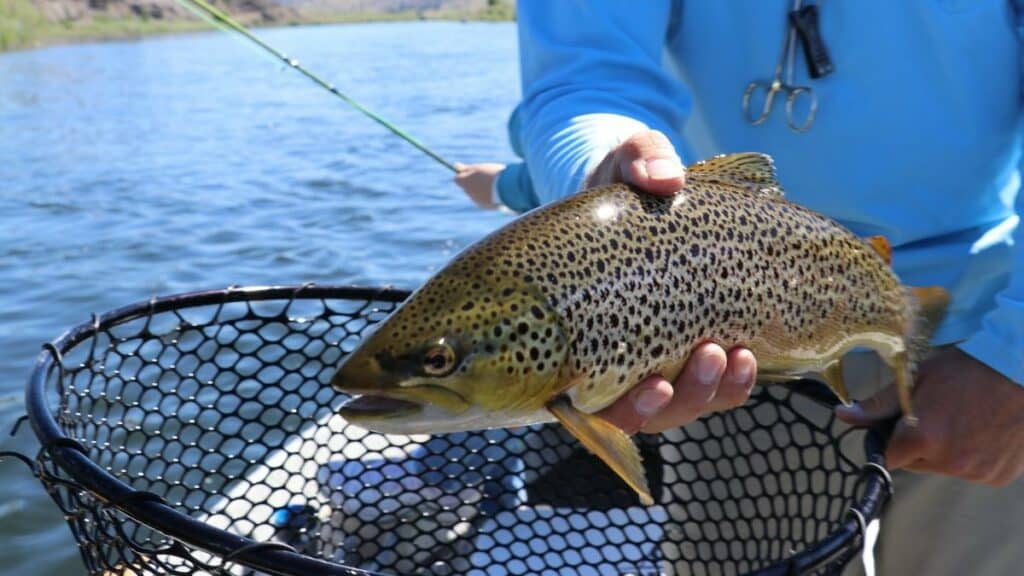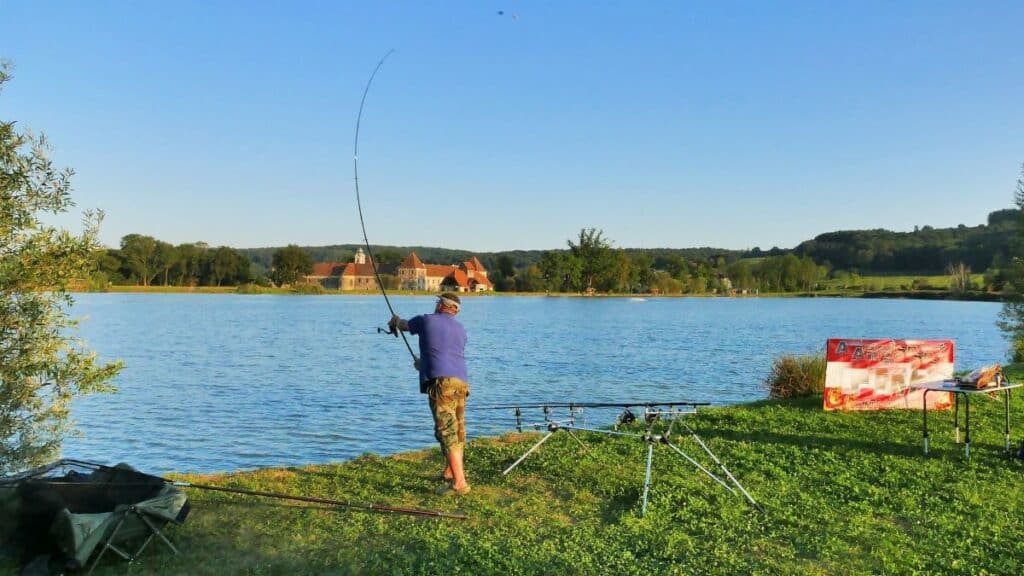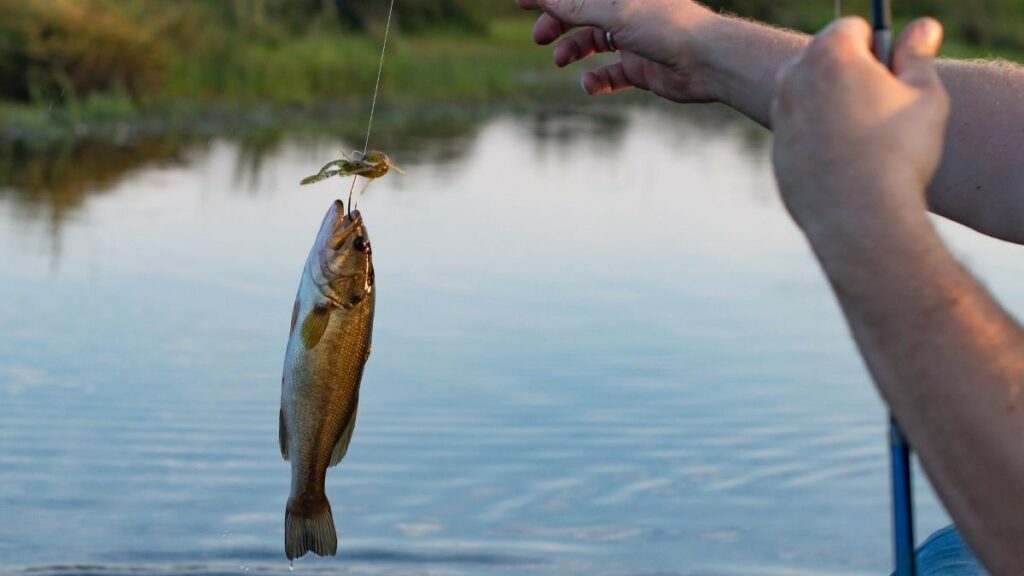Trout Fishing Tips for Beginners: There are many fishing enthusiasts who have heard about trout fishing but never got a chance to learn how to catch trout. This is the reason why we wrote this article.
We hope this guide can help you get started with trout fishing. We have included many trout fishing tips for beginners, but more experienced trout fishermen may also find a few useful tricks.
Trout Fishing Tips for Beginners
In this guide, we will discuss:
- Trout Fishing Gear That You Need
- 4 Trout Fishing Methods That Work
- Tips For Finding More Trout Every Day
- 9 Lures You Can Use For Catching Trout
- 3 Simple Trout Fishing Tips For Beginners
- Fish Care: How To Catch And Release
But first, a little about trout fish.
About Trout Fish
We start off by trying to know what is trout that is being talked about here. There are several types of fish that are commonly known as trout. They are classified into three species: Salmo, Oncorhynchus, or Salvelinus.
One feature that they all have in common is fresh water. Trout are mostly located in rivers, streams, lakes, and ponds. But we also know that some trout may wander off to the ocean. But they always return to freshwater to spawn.
The most common types of trout are brown trout, rainbow trout, steelhead, and lake trout. The diet of trout fish is simple. Their diet consists of other fish and aquatic invertebrates. But when the trout reach over 12 inches, they only feed on other small fishes.
Trout Fishing Gear That You Need
The basic trout fishing rig is a spinning reel, light or medium action rod, 4-8lb test fluorocarbon line, and some lures. There are some other things that you may require, ranging from a sling pack, camera, bug spray, sunglasses, and sunscreen.
You should also look at getting some safety gear like fishing waders to keep you dry and a fishing vest to keep you safe.
Fishing Rod
You need a fishing rod to catch trout. Most fishing rods fall under three categories: spinning, fly, and casting rods. But choosing a fishing rod can be difficult as there are so many different options to choose from.
The first thing you need to do is determine what type of water you will be fishing on the most. If you will be fishing in small streams, then a short rod as it is easier to maneuver and cast in tight spaces.
If you will be fishing in lakes or rivers, then a longer rod will give you more reach and help you cast further.
Next, decide how much money you want to spend on your new fishing rod. There are plenty of options at different price points available on the market today.
Try out different rods at your local fishing store or read reviews before you buy one. You can check out some of the Best Trout Fishing Rods to help you pick the right rod. Ensure that you match your rod with the right reel.
Fishing Reel and Line
You need a reel to go with your trout fishing rod. You will need to choose between conventional, spin-cast, or spinning reels. The spinning reels are preferred for beginners as they are easy to use.
Choose a matching reel that is good quality and strong. You can check out our review of the Best Spinning Reel Under 100 if you need help finding a suitable reel for your trip.
Baits and Lures for Trout
Also, ensure that you get some baits and lures. But, it is important you get the right kind of lure.
When you are trout fishing always remember that Powerbait works best only on stocked trout. Also, trout which are over a foot long will cut insects, as well as flies out of their diet.
If you want a big trout, then you need to avoid mayflies, flies, or any tiny-haired imitators. The big trout which are more than one foot in length will eat worms, smaller fish, larger insects, and shrimp.
4 Trout Fishing Methods That Work
Drift Fishing
This is a kind of fishing that needs a person to be patient. This is a technique that can easily bore you. But the good part is that as you gain experience, you will start enjoying the finer aspects of this method.
In this method, you put your bait or lure and let it flow with the current. This technique is performed in flowing water, especially rivers and streams. The most important point in this method is where you place yourself in the river.
You should look for places where you can get the right amount of drift. Otherwise, it would be difficult to catch trout using this method. You may need a fishing kayak to position yourself in the best spot.
Float Fishing
This method of trout fishing is used in places where there is little current. You can use this method to catch trout in streams and rivers. This style works well because trout are known to be lazy.
When you are fishing in a river or a stream, you will find trout positioning themselves towards the top. Trout behave this way so that the current brings them food as it moves along.
Most experienced anglers use fly reels for float fishing. But many beginners prefer spinning reels as they are easier to use. You can check out our list of the Best Trout Spinning Reels if you are looking for a new spinning reel for your fishing trip.
Fishing with Jigs
If you want to use jigging, then we recommend that you bring a good fish finder. It is not a must that you buy an expensive fish finder. Even the more affordable ones will get the job done.
You need a fish-finder so that you can get the path of the fish and its depth. After that, place your jig where you have found the fish. Then allow the jig to have a free fall into the water up to a meter below the fish.
Bottom Fishing
Bottom Fishing is the most beginner-friendly and easiest method to catch trout. Yet you will find this method to be very effective in slow-moving water.
In this method, you rig a hook and bait and let the bait settle at the bottom. You need to ensure that you keep a tight line and never move the bait. This will ensure that it comes across naturally to the fish.
Always be on the watch for even a slight movement in your rod as the fish may bite very lightly.
Finding Trout in Lakes, Ponds, Rivers, and Streams
Where to Find Trout
Trout are mostly found in cold and moving water. Trout are known to run up and down creeks and rivers. They are also found in lakes and that is why they are termed lake trout.
Trout can be dropped in lakes, ponds, rivers, streams, and anywhere where water exists. They will survive well. This makes trout the most commonly stocked game species of fish.
One unique thing about trout is that the more a river or lake is remote, the more the chances to find trout there swimming and enjoying their life. This is another reason why trout fishing is always a fun activity to do. It will more likely make you go outside your comfort zone while tracking them down.
When it comes to picking a fly rod for trout fishing, keep in mind that it must be lightweight and easy to use.
Trout are also loved by wildlife as they become a good source of food. That means they can be found in woods where bears, bobcats, and other kinds of wildlife exist.
When to Go Trout Fishing
The best time that you can go trout fishing in lower elevation lakes is during spring and fall. At this time, the water is cooler and trout seem to be more active. At this time, most lakes are stocked.
If you are an angler and have come to the warm summer months, look for your trout in cooler and deeper waters. You can also find them in mountain lakes that are known to be cool all year round.
Finding Trout in Lakes and Ponds
The best places to fish for trout in lakes and ponds are near or above aquatic vegetation. You can also find trout around rocks, stumps, and logs around stream inlets. Trout frequent these areas looking for food.
You can find trout in deep lakes too. You can find them feeding on small fish that are found in the depth of the lakes. They also attack or raid during the salmon spawn.
Trout in deep lakes can grow to massive sizes and even put up strong fights that are mostly found in oceans. You will enjoy its size and be mesmerized.
Spring and fall seasons are the best time for fishing trout in lakes. During these seasons, trout are active and most lakes are stocked.
During the warm summer months, you can still get trout in the cooler waters. Just go to deeper waters and you will get several of them.
You can also get them in high mountain lakes since they remain cool all throughout the year. This time trout will be looking for cooler water and protection against their predators.
Finding Trout In Rivers And Streams
Before you go trout fishing, do some research to find out about the river or stream where you would be fishing. If you wish to avoid guesswork and save energy, find out about the deep pools. This knowledge will help you find trout with much lesser effort.
Deep pools that are created by the current will accommodate larger trout. You can harvest large trout easily during dawn and dusk. Don’t be surprised if you catch some smaller trout as well.
Shallow pools will give you smaller trout, which is great if interested in small trout. You can also find trout behind rocks and other structures. Trout use these structures to rest from the current.
With these tips in mind, you’ll be fishing trout like a pro! You can get tons of trout depending on your energy to fish them. Just choose the right lure and you will never miss your opportunities.
9 Lures You Can Use For Catching Trout
Do you know the right types of lures to use? Well, if you don’t know, then here are the 9 kinds of lures that you can use for trout fishing. You should ideally carry at least one of each on your trout fishing trip.
Critters
There are some creatures that naturally fall into the river and trout get used to seeing them. These living organisms include beetles, grasshoppers, crickets, and other large bugs. You can use these creatures as live bait to catch a lot of trout. You can also use imitators for trout fishing.
Swimbaits
Do you know that trout love eating smaller baitfish? Bigger trout, especially, love eating these smaller baitfish. You can use the paddle tail swimbait for catching trout.
Tubes
Most experienced fishermen know that tubes look like zooplankton and trout like feasting on it. When you keep tubes in your tackle box, there is a possibility of catching a lot of trout.
Worm Imitators
Every fish bites live worms. And trout are no exception. You can be sure that using worm imitators is one of the most widely used tricks for catching trout. You can use soft plastic worms that come in bright colors. Worm imitators are simple to use and beginner-friendly. These can be very effective in moving water.
Crankbaits
The crankbaits are not your usual go-to lure for catching trout. But remember that large trout will bite portions even if the fish is too big to swallow.
Salmon Eggs
Do you know that trout are great scavengers? Just use salmon eggs with a size 6 hook and you’ll catch tons of trout.
Spoons
Get flashy spoons that are tipped with feathers. You can use spoons to effectively catch trout all year long. But they are most effective in colder weather.
Spinners
Spinners and roosters are some of the most commonly used lures across all states. You can use spinners and roosters to catch trout in lakes as well as rivers.
Powerbait
Powerbait works great with stock trout. You just need a few colors of power baits and you will see tons of trout!
Trout Fishing Tips for Beginners
Fishing Rods and Reels
When choosing a fishing rod and reel, it’s important to first understand what type of fish you’re going after, the type of water you’ll be fishing in, the size and weight of your bait, and whether or not you’ll be using live bait.
After understanding these things, you can then better choose the appropriate fishing equipment. Beginners who want to enjoy fly fishing with smaller lures can check out the best fly reels under 100 reviews and buyer’s guide.
Inline Spinners
Inline Spinners are a kind of baitfish imitator. Stream trout love eating small baitfish. When the trout get bigger, they like these small baitfish even more. This makes inline spinners the most preferred lure for catching big trout all around the year.
Inline spinners are snag-free and easy to cast. One of the first trout fishing tips for beginners is to pack inline spinners along with other tackle. Thanks to their ease of use and effectiveness, they are a must-have lure for trout fishing.
Nymphs and Streamers
You can use nymphs and streamers to catch trout and then catch some more. Especially if you are fly fishing trout.
Trout love nymphs and other sub-surface creatures such as scuds. That is why they make excellent lures to catch trout. You can use either bead-head nymphs or soft plastic nymphs as lures.
Live Bait
Using live bait is the easiest method for beginners to catch trout fish. But you must check if using live bait is permitted in the area where you are fishing.
Beginners can use a night crawler or minnow to catch trout effortlessly. Trout will bite live bait much more often, and this can help speed up your learning curve.
Fish Care: How to Catch and Release
If you have caught a fish and you want to release it, here is what you need to do:
- Always use a barbless hook as it will prevent injuring the fish
- Ensure you always wet your hand before you handle the trout.
- Avoid removing the trout from the water.
- Don’t make the fish tire too much. You can do this by landing the fish quickly.
- If you’re interested in taking a photo, then have your camera set before lifting the trout out of the water.
- Take the picture quickly and land the fish as soon as possible.
- You should remove the hook using needle-nosed pliers
- Don’t forget to revive the trout in the water before letting it go
Trout Fishing Tips for Beginners – Conclusion
You can now gear up and start catching more trout with much less effort. With these trout fishing tips, you’ll get a box of trout each time you go fishing. We hope this guide will help you learn how to fish trout and increase your chances of harvesting more fish.
If you have any trout fishing tips of your own that you would like to share, then you can use the comments section.





